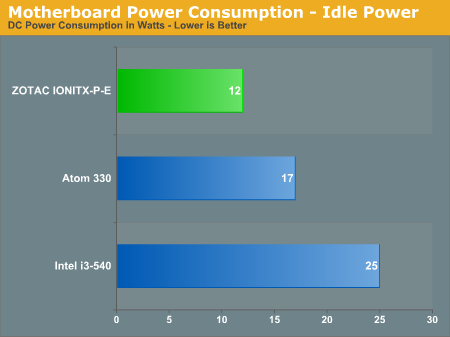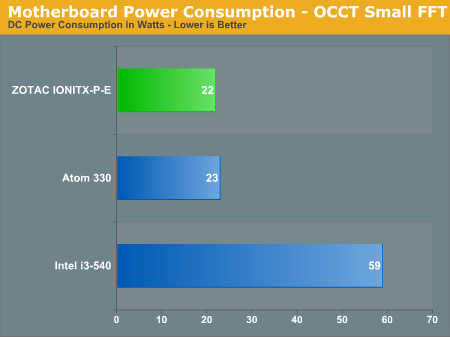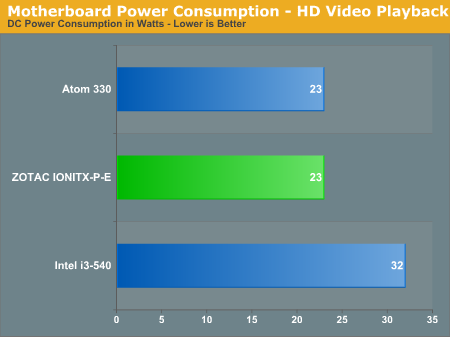ZOTAC IONITX-P-E: Can Intel's CULV Processors Reinvigorate Interest in NVIDIA's ION?
by Rajinder Gill on August 26, 2010 9:00 AM EST- Posted in
- Motherboards
- Intel
- Mini ITX
- ZOTAC
- NVIDIA
|
Testbed Setup Overclocking / Benchmark Testbed |
|
| Processors |
1 x Intel i3-540 - 3.06GHz, 2 Cores 4 threads, 4MB L3 Cache Intel CULV Celeron Su2300 1.2GHz, 800MHz FSB, 2 Cores, 1MB L3 Cache Intel Atom 330, 533 MHz FSB, 2 Cores, 1MB L3 Cache |
| CPU Voltage | Various |
| Cooling | Intel air cooler, stock motherboard air cooling for IONs. |
| Power Supply | Enhance ENP-2320 200W PSU, Corsair HX950 (used for 275 GTX) |
| Memory |
CorsairXMS3 CMX8GX3M4A1333C9 DDR3-1333 CAS 9-9-9-24 2x2GB kit Corsair Dominator GT 8-8-8-24 DDR3-2200 2x2GB kit Crucial Ballistix BL2566F4N1608 DDR3-1600 8-8-8-24 2x2GB kit |
| Memory Settings | Various |
| Video Cards | MSI 275 Lightning (stock clocks) |
| Video Drivers | NVIDIA 258.96 WHQL |
| Hard Drive |
Western Digital 7200RPM 1TB SATA 3/Gbps 32MB Buffer OCZ Vertex 120GB SSD |
| Optical Drives | Plextor PX-B900A, Toshiba SD-H802A |
| Case | Open Test Bed |
| Operating System | Windows 7 64 bit |
| . | |
We utilized memory kits from Corsair and G.Skill to verify memory compatibility on our test boards. Our OS and primary applications are loaded on the OCZ Vertex 120GB SSD drive and our games operate off the WD Caviar Black 1TB drive. We did a clean install of the OS and applications for each motherboard. For graphics duty, MSI’s GTX N275 GPU is used to provide performance comparisons between boards during gaming benchmarks.
ECS's H55H-I mini-ITX board was used to provide the Clarkdale i3-540 numbers, while ASUS's AT3IONT-I was used for the Atom 330 results. We set up each board with platform defaults, and match up primary memory timings and memory frequency. The ION platforms were run at CAS 7-7-7-20 2T DDR3-1333, while the i3-540 Clarkdale was run at 7-7-7-20 1T DDR3-1333. We did not manage to engage a 1T Command Rate on the ION platform as both boards refused to POST with all of our test memory modules, so had to settle for 2T instead.
The natural choice for comparison would be a G6950, unfortunately I don't have one of those in my possession at present so we've had to make do with the i3-540 instead. The G6950 touts a 2.8GHz clock speed albeit lacking Turbo and Hyper threading, so should sit neatly between the i3-540 and SU2300 Celeron results in most benchmarks.
Power Consumption
Our power consumption testing utilizes the same batch of components under similar circumstances in a bid to monitor variances between idle and CPU load conditions. We install the vendor supplied power saving utilities on each board (when available) and enable power saving modes that don't involve any kind of underclocking or CPU core frequency modulation in order to run an apples to apples comparison.
ATX PSU switching losses are absent from our figures because we monitor power consumption directly at the DC rails of the PSU. These figures measure only the CPU, motherboard and memory DC power draw and exclude any other peripherals, such as cooling fans and hard drives etc. AC power consumption at the wall will be anywhere from 15~40% higher than these figures depending upon the efficiency of your power supply.



The CULV SU2300 improves on the idle power consumption of Atom. The i3-540 isn't that far adrift when you consider the additional horsepower and 3.06GHz operating frequency. In most loading scenarios, you'll be giving up 10W of power in return for a more capable all-round PC. As we're dealing with desktop systems here and not mobile devices, we think the 10W gap shouldn't be of concern to most users.










42 Comments
View All Comments
-BubbaJoe- - Friday, August 27, 2010 - link
We need a review on the new Asus M4A88T-I DELUXEIts a mini-itx motherboard for AM3 with a crapton of features (usb 3 wifi n, bluetooth, etc)
I already purchased this board and I can attest, the thing is awesome, the 95w cpu support is a bit lacking but I have it paired with an Athlon II x3 445 (3.1ghz), you can even put one of the quad core phenoms or the lower power 6 cores that are supposed to be out soon. It absolutly flies with the 5770. I'd just like to see a full review and what kind of over clock potential it has on a small wattage psu (my case came with a 300w).
Just more exposure to the awesomeness that is mini-itx at a price point lower than Intel.
hvakrg - Friday, August 27, 2010 - link
If this had come with a chipset that could bitstream TrueHD I'd be all over it, replace Ion with MR5xxx and it would be great.ssj3gohan - Friday, August 27, 2010 - link
I have a much-overlooked but very serious request to the Anandtech testers - I know we readers demand a lot but this is not that bad a request I think.In building the odd core i3 system, even with the excellently power-efficient Intel DH55TC board, I get idle power of around 20W and load power of around 50W. While that 20W figure is actually very favourable from a heat/noise/performance per watt point of view, the load power isn't, especially when we're looking at these types of systems aimed at low power. People feel they really have to choose: go for the truly low-power SU7xxx/Atom-based system but give up the ability to... well, really do any real computing, and on the other hand go for the full-featured system but having to cope with the necessary active cooling and power drain.
This is not true, because core i3 and i5 processors actually undervolt quite a bit. I have undervolted systems very non-aggressively (mind the prefix 'non') and gained over 12W difference in load power: that is still 20W idle power, but just 38W under load. That is very competitive with the CULV-stuff around there, especially considering the MASSIVE performance increase. The real power zealots will probably say I have to use a picopsu to get everything even more efficient but that is really not worth the cost anymore in this realm. Undervolting is, and that is why I ask you to consider this in future benchmarks of this kind of systems.
ProDigit - Friday, August 27, 2010 - link
You got all the extra options, but nowhere near enough low power to compete with netbooks.Also no multi-thread compatibility.
Necrosaro420 - Friday, August 27, 2010 - link
What is that coax cable for?Rajinder Gill - Friday, August 27, 2010 - link
Wi-FiGigantopithecus - Friday, August 27, 2010 - link
IMHO overpriced across the board. (Pun intended.)Cerb - Friday, August 27, 2010 - link
Otherwise, it looks very...OK. But no such system, today, needs a fan. Given the cost of the whole thing, it would easily be worth an extra $10-15 to have a proper heatsink for it all, instead.Even if they did that, though, Mr. Gill's conclusion about what you get for the price would still keep it from being a great buy.
hvakrg - Saturday, August 28, 2010 - link
"That leaves one more weapon in IONs current repertoire that may factor in swaying a purchasing decision; XBMC support - it appears Clarkdale is not currently/well supported by Linux for such use. If looking for full media center functionality, ION remains the better choice."XBMC is not the only media center application out there, and it does not even offer full media center functionality with it's lack of basic TV-support. Mediaportal on the other hand does.
KOOLTIME - Saturday, August 28, 2010 - link
I use it running WIN 2008 server, is been excellent for that. No not a high demand server, but its perfect for file share, DHCP, back up server. Super low cost for a low demand server is unbeatable.Mines been runing great since i set it up no problems whatsoever, its low power and low profile make it excellent for running 24/7 at a cheep price for home network server.
zotac w/atom 330 cpu - 2gb ram - 2x 1tb HD's + case - psu - cd drive all less then 400 bucks for the rig, and its been uptime 24/7 just over 6 months now with zero problems as my DHCP, file, proxy, and back up server.
For home user that doesnt want to spend alot of money and has use for background computer services ( aka HTPC, file server, basic networking services, those types of things. Cant beet it for the cost. The small form and the low power means it can be on 24/7 with no big dents to the wallet.
Only note I would recommend when getting these types of systems, is insure you get dual core or better type of CPU, the single cores simply dont have enough juice to not LAG the heck outta the system even for simple tasks as launching a web browser and such. A dual core least remains usable even though its not a speed deamon you can do basic stuff without waiting 2-5 mins per mouse click as some of these single core models do.
Go test out an atom N450 vs a 330 and you will see why to not buy an N450 ever for use, those single cores are lag monkies.